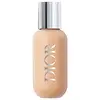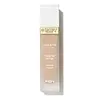What's inside
What's inside
 Key Ingredients
Key Ingredients

 Benefits
Benefits

 Concerns
Concerns

 Ingredients Side-by-side
Ingredients Side-by-side

Water
Skin ConditioningC9-12 Alkane
SolventPropanediol
SolventCaprylic/Capric Triglyceride
MaskingUndecane
EmollientPolyglyceryl-6 Polyricinoleate
EmulsifyingGlycerin
HumectantTridecane
PerfumingCellulose
AbsorbentTrimethylsiloxysilicate
EmollientLecithin
EmollientAlcohol
AntimicrobialPentylene Glycol
Skin ConditioningPolyglyceryl-10 Decaisostearate
EmollientSilica
AbrasivePolyglyceryl-2 Isostearate
EmulsifyingStearalkonium Hectorite
Gel FormingDisteardimonium Hectorite
StabilisingParfum
MaskingHydroxypropyl Starch
Sodium Chloride
MaskingSodium Myristoyl Glutamate
CleansingPropylene Carbonate
SolventCoco-Caprylate/Caprate
EmollientHydroxyacetophenone
AntioxidantSodium Benzoate
MaskingSqualane
EmollientAluminum Hydroxide
EmollientTocopherol
AntioxidantStearoyl Glutamic Acid
CleansingPolyhydroxystearic Acid
EmulsifyingHyaluronic Acid
HumectantCitric Acid
BufferingIsostearic Acid
CleansingPolyglyceryl-3 Polyricinoleate
EmulsifyingCI 77891
Cosmetic ColorantCI 77491
Cosmetic ColorantCI 77492
Cosmetic ColorantCI 77499
Cosmetic ColorantWater, C9-12 Alkane, Propanediol, Caprylic/Capric Triglyceride, Undecane, Polyglyceryl-6 Polyricinoleate, Glycerin, Tridecane, Cellulose, Trimethylsiloxysilicate, Lecithin, Alcohol, Pentylene Glycol, Polyglyceryl-10 Decaisostearate, Silica, Polyglyceryl-2 Isostearate, Stearalkonium Hectorite, Disteardimonium Hectorite, Parfum, Hydroxypropyl Starch, Sodium Chloride, Sodium Myristoyl Glutamate, Propylene Carbonate, Coco-Caprylate/Caprate, Hydroxyacetophenone, Sodium Benzoate, Squalane, Aluminum Hydroxide, Tocopherol, Stearoyl Glutamic Acid, Polyhydroxystearic Acid, Hyaluronic Acid, Citric Acid, Isostearic Acid, Polyglyceryl-3 Polyricinoleate, CI 77891, CI 77491, CI 77492, CI 77499
Water
Skin ConditioningDicaprylyl Carbonate
EmollientC9-12 Alkane
SolventGlycerin
HumectantIsododecane
EmollientCaprylyl Methicone
Skin ConditioningButylene Glycol
HumectantIsodecyl Neopentanoate
EmollientDimethicone/Vinyl Dimethicone Crosspolymer
Skin ConditioningDimethicone
EmollientBoron Nitride
AbsorbentPentylene Glycol
Skin ConditioningPolyglyceryl-4 Isostearate
EmulsifyingCetyl PEG/PPG-10/1 Dimethicone
EmulsifyingHexyl Laurate
EmollientHydrogenated Polydicyclopentadiene
Sodium Chloride
MaskingSaccharide Isomerate
HumectantPanthenol
Skin ConditioningTocopheryl Acetate
AntioxidantHydrolyzed Soy Protein
HumectantAdenosine
Skin ConditioningPrunus Serrulata Flower Extract
Skin ConditioningSalix Alba Leaf Extract
Skin ConditioningAlgae Extract
EmollientAlbizia Julibrissin Bark Extract
MaskingVitis Vinifera Leaf Extract
Skin ConditioningPolysilicone-11
Synthetic Fluorphlogopite
Stearalkonium Hectorite
Gel FormingHydrogenated Lecithin
EmulsifyingDimethiconol
EmollientPropylene Carbonate
SolventSilica
AbrasiveIsoceteth-10
EmulsifyingCitric Acid
BufferingSodium Citrate
BufferingEthylhexylglycerin
Skin ConditioningParfum
MaskingSorbic Acid
PreservativePhenoxyethanol
PreservativeSodium Benzoate
MaskingPotassium Sorbate
PreservativeCI 77891
Cosmetic ColorantIron Oxides
Mica
Cosmetic ColorantWater, Dicaprylyl Carbonate, C9-12 Alkane, Glycerin, Isododecane, Caprylyl Methicone, Butylene Glycol, Isodecyl Neopentanoate, Dimethicone/Vinyl Dimethicone Crosspolymer, Dimethicone, Boron Nitride, Pentylene Glycol, Polyglyceryl-4 Isostearate, Cetyl PEG/PPG-10/1 Dimethicone, Hexyl Laurate, Hydrogenated Polydicyclopentadiene, Sodium Chloride, Saccharide Isomerate, Panthenol, Tocopheryl Acetate, Hydrolyzed Soy Protein, Adenosine, Prunus Serrulata Flower Extract, Salix Alba Leaf Extract, Algae Extract, Albizia Julibrissin Bark Extract, Vitis Vinifera Leaf Extract, Polysilicone-11, Synthetic Fluorphlogopite, Stearalkonium Hectorite, Hydrogenated Lecithin, Dimethiconol, Propylene Carbonate, Silica, Isoceteth-10, Citric Acid, Sodium Citrate, Ethylhexylglycerin, Parfum, Sorbic Acid, Phenoxyethanol, Sodium Benzoate, Potassium Sorbate, CI 77891, Iron Oxides, Mica
 Reviews
Reviews

Ingredients Explained
These ingredients are found in both products.
Ingredients higher up in an ingredient list are typically present in a larger amount.
C9-12 Alkane is synethically created using alkanes, or paraffins. It is added to products as a solvent. This means its main purpose is to help dissolve ingredients and create even texture.
Ci 77891 is a white pigment from Titanium dioxide. It is naturally found in minerals such as rutile and ilmenite.
It's main function is to add a white color to cosmetics. It can also be mixed with other colors to create different shades.
Ci 77891 is commonly found in sunscreens due to its ability to block UV rays.
Learn more about CI 77891Citric Acid is an alpha hydroxy acid (AHA) naturally found in citrus fruits like oranges, lemons, and limes.
Like other AHAs, citric acid can exfoliate skin by breaking down the bonds that hold dead skin cells together. This helps reveal smoother and brighter skin underneath.
However, this exfoliating effect only happens at high concentrations (20%) which can be hard to find in cosmetic products.
Due to this, citric acid is usually included in small amounts as a pH adjuster. This helps keep products slightly more acidic and compatible with skin's natural pH.
In skincare formulas, citric acid can:
While it can provide some skin benefits, research shows lactic acid and glycolic acid are generally more effective and less irritating exfoliants.
Most citric acid used in skincare today is made by fermenting sugars (usually from molasses). This synthetic version is identical to the natural citrus form but easier to stabilize and use in formulations.
Read more about some other popular AHA's here:
Learn more about Citric AcidGlycerin is already naturally found in your skin. It helps moisturize and protect your skin.
A study from 2016 found glycerin to be more effective as a humectant than AHAs and hyaluronic acid.
As a humectant, it helps the skin stay hydrated by pulling moisture to your skin. The low molecular weight of glycerin allows it to pull moisture into the deeper layers of your skin.
Hydrated skin improves your skin barrier; Your skin barrier helps protect against irritants and bacteria.
Glycerin has also been found to have antimicrobial and antiviral properties. Due to these properties, glycerin is often used in wound and burn treatments.
In cosmetics, glycerin is usually derived from plants such as soybean or palm. However, it can also be sourced from animals, such as tallow or animal fat.
This ingredient is organic, colorless, odorless, and non-toxic.
Glycerin is the name for this ingredient in American English. British English uses Glycerol/Glycerine.
Learn more about GlycerinParfum is a catch-all term for an ingredient or more that is used to give a scent to products.
Also called "fragrance", this ingredient can be a blend of hundreds of chemicals or plant oils. This means every product with "fragrance" or "parfum" in the ingredients list is a different mixture.
For instance, Habanolide is a proprietary trade name for a specific aroma chemical. When used as a fragrance ingredient in cosmetics, most aroma chemicals fall under the broad labeling category of “FRAGRANCE” or “PARFUM” according to EU and US regulations.
The term 'parfum' or 'fragrance' is not regulated in many countries. In many cases, it is up to the brand to define this term.
For instance, many brands choose to label themselves as "fragrance-free" because they are not using synthetic fragrances. However, their products may still contain ingredients such as essential oils that are considered a fragrance by INCI standards.
One example is Calendula flower extract. Calendula is an essential oil that still imparts a scent or 'fragrance'.
Depending on the blend, the ingredients in the mixture can cause allergies and sensitivities on the skin. Some ingredients that are known EU allergens include linalool and citronellol.
Parfum can also be used to mask or cover an unpleasant scent.
The bottom line is: not all fragrances/parfum/ingredients are created equally. If you are worried about fragrances, we recommend taking a closer look at an ingredient. And of course, we always recommend speaking with a professional.
Learn more about ParfumPentylene glycol is typically used within a product to thicken it. It also adds a smooth, soft, and moisturizing feel to the product. It is naturally found in plants such as sugar beets.
The hydrophilic trait of Pentylene Glycol makes it a humectant. As a humectant, Pentylene Glycol helps draw moisture from the air to your skin. This can help keep your skin hydrated.
This property also makes Pentylene Glycol a great texture enhancer. It can also help thicken or stabilize a product.
Pentylene Glycol also acts as a mild preservative and helps to keep a product microbe-free.
Some people may experience mild eye and skin irritation from Pentylene Glycol. We always recommend speaking with a professional about using this ingredient in your routine.
Pentylene Glycol has a low molecular weight and is part of the 1,2-glycol family.
Learn more about Pentylene GlycolThis ingredient is a solvent. It helps dissolve active ingredients and alter the texture of products.
Propylene Carbonate is commonly used in makeup and with clay, such as montmorillonite or bentonite.
Studies show this ingredient to be safe for cosmetics. When it is undiluted, it can cause skin irritation. (It is always diluted in skincare and makeup). This ingredient is water-soluble.
Propylene Carbonate is created from propylene glycol and carbonic acid.
Learn more about Propylene CarbonateSilica, also known as silicon dioxide, is a naturally occurring mineral. It is used as a fine, spherical, and porous powder in cosmetics.
Though it has exfoliant properties, the function of silica varies depending on the product.
The unique structure of silica enhances the spreadability and adds smoothness, making it a great texture enhancer.
It is also used as an active carrier, emulsifier, and mattifier due to its ability to absorb excess oil.
In some products, tiny microneedles called spicules are made from silica or hydrolyzed sponge. When you rub them in, they lightly polish away dead skin layers and enhance the penetration of active ingredients.
Learn more about SilicaSodium Benzoate is a preservative. It's used in both cosmetic and food products to inhibit the growth of mold and bacteria. It is typically produced synthetically.
Both the US FDA and EU Health Committee have approved the use of sodium benzoate. In the US, levels of 0.1% (of the total product) are allowed.
Sodium benzoate works as a preservative by inhibiting the growth of bacteria inside of cells. It prevents the cell from fermenting a type of sugar using an enzyme called phosphofructokinase.
It is the salt of benzoic acid. Foods containing sodium benzoate include soda, salad dressings, condiments, fruit juices, wines, and snack foods.
Studies for using ascorbic acid and sodium benzoate in cosmetics are lacking, especially in skincare routines with multiple steps.
We always recommend speaking with a professional, such as a dermatologist, if you have any concerns.
Learn more about Sodium BenzoateChances are, you eat sodium chloride every day. Sodium Chloride is also known as table salt.
This ingredient has many purposes in skincare: thickener, emulsifier, and exfoliator.
You'll most likely find this ingredient in cleansers where it is used to create a gel-like texture. As an emulsifier, it also prevents ingredients from separating.
There is much debate on whether this ingredient is comedogenic. The short answer - comedogenic ratings don't tell the whole story. Learn more about comegodenic ratings here.
The concensus about this ingredient causing acne seems to be divided. Research is needed to understand if this ingredient does cause acne.
Scrubs may use salt as the primary exfoliating ingredient.
Learn more about Sodium ChlorideStearalkonium Hectorite is a clay-derived ingredient used to thicken a product and help create a gel-like texture.
Water. It's the most common cosmetic ingredient of all. You'll usually see it at the top of ingredient lists, meaning that it makes up the largest part of the product.
So why is it so popular? Water most often acts as a solvent - this means that it helps dissolve other ingredients into the formulation.
You'll also recognize water as that liquid we all need to stay alive. If you see this, drink a glass of water. Stay hydrated!
Learn more about Water